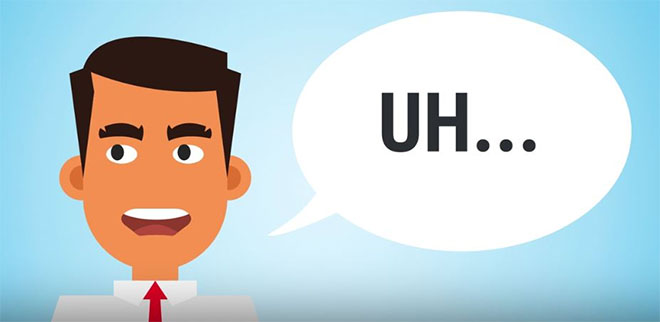How to Avoid Annoying your Audience when Public Speaking
Updated June 13, 2018 - Dom Barnard
When people talk about distractions during a speech, they’re mostly referring to ones made by the audience, technological issues, or something else beyond your control. However, you could be a distraction to your own speech.
In this article, we discuss some of the most annoying things you might be doing and their solutions.
1. Use of language and jargon
One of the biggest distractions to your speech is when your audience don’t understand what you’re talking about. Your presentation should be written with your audience in mind and structured so that it’s easy for them to digest.
Solution: Avoid using jargon and acronyms that isolate some members of the audience. If you’re at a work event and you’re confident that the audience use the same language as you, then you can use it. But if more than 5-10% of people won’t understand what you’re saying then it’s best to use language that everyone will understand.
2. Not tailoring your message to the audience
The audience are likely to engage with and respond well to a speech that's specifically tailored to them. Producing a generic presentation is easier but it's unlikely to meet the audience's needs and may even upset them if it's obvious.
Solution: Do your research beforehand and ask yourself:
- What are the characteristics of my audience, such as gender, age, socio-economic status, occupation, etc
- What do they want to know?
- How can I help them?
- How much do they already know?
Also personalise your questions so it feels like you're speaking to each audience member individually by using "you" and "your." For example: asking "Do you want to protect your children?" would be more effective than asking "Does anyone here want to protect their children?"
3. Staring at distractions
Your audience or environment may distract you in some way during your talk. Whether it’s a phone going off, someone arriving late, bright lighting or a group of people having a discussion in the middle of your speech. It’s easy to draw attention to the culprits in the audience but you’ll actually end up distracting the rest of the audience even more.
Solution: Ignore distractions and divert the audience’s attention to the opposite side of the room. Raise your voice slightly and walk to the other side of the room and your audience’s attention should follow you. You can practice dealing with distractions in our virtual reality course.

Practice dealing with distractions in the VirtualSpeech VR app. Stage lighting distraction shown above.
4. Lacking energy
How you say something is just as important as the content of your speech - arguably, more so. For example, if an individual presented on a topic very enthusiastically the audience would probably enjoy this compared to someone who covered more points but mumbled monotonously into their notes. The audience wants to see that you are enthusiastic and are interested in talking to them about this topic.
Solution: You need to show your interest and enthusiasm - the following tips can help:
- Adapt your voice depending on what are you're saying- if you want to highlight something then raise your voice or lower your voice for intensity
- Avoid speaking in monotone
- Speak loudly and clearly
- Smile
5. Pacing on stage
A common public speaking tip is to move around the stage - whether that’s to calm your nerves, let a point settle or to include different sections of the room. However, there's a limit to how much pacing is comfortable for your audience.
If you’re pacing constantly or every 30 seconds then your audience will be distracted from your message because they’re too busy following you. You also risk sight-line issues and people craning their necks or leaning close to each other to see you.
Solution: Move to one side of the room when you're making one significant point, while still looking at every area of the room, and then walk back to the other side when making a different point. There should be at least a few minutes on each side of the stage, depending on how long your speech is.
6. Using only one of the three appeals
Ethos, logos and pathos are modes of persuasion used to convince and appeal to an audience:
- Ethos: the ethical appeal
- Pathos: the emotional appeal
- Logos: the logical appeal
You need these qualities for your audience to accept your messages. If you exclude one of these appeals from your presentation you may not produce a persuasive speech. For example, if you only used pathos, the audience may think that your statements lack credibility.
Solution: Treat all three pillars with equal importance and use all of them in your presentation. It's especially tempting to provide the audience with lots of data (logos) because you want to support your statements. But too much data will reduce interest levels - the meaning is more important than exact statistics.
7. Not rehearsing properly
Some speakers worry that too much practice will make them sound unnatural but the best speakers rehearse their presentations multiple times. Practicing has these benefits:
- It's respectful to your audience - if you fail to practice before your presentation you may look unprepared which the audience may interpret as disinterest. They may not listen to you or they may actively try to find flaws in your speech.
- You become familiar with the content so your speech flows more and sounds natural rather than unnatural. "The rehearsal is the work and the performance is the relaxation." (Michael Caine).
- Highlights what changes you need to make to the content and its organisation.
- Allows you to adjust your pace and body language.
- Shows you which parts of the speech your struggle to verbalise.
- Increases your confidence.
Solution: Practice until you can say that you're completely happy. You can practice in front of the mirror and in front of others. But the best way to prepare for your speech is to film yourself repeatedly and work on your weaknesses, or use VR to practice in a more realistic way.
8. Lacking eye contact
When you feel nervous you may struggle to maintain sustained eye contact with the audience. Your eyes may dart around the room and land on different people without pausing. People perceive this negatively, for example, they may interpret you as:
- Insincere
- Dishonest
- Uninterested
- Insecure etc
Solution: Maintain eye contact with one person for at least three seconds or long enough to complete a sentence. If you find that you are too uncomfortable to give audience members direct eye contact, a helpful technique is to look directly over the heads of the audience as this gives the impression of eye contact.

9. Using a pointer
If you’re speaking with a presentation behind you, you might use a pointer so that you can direct the audience to different areas of the screen. Whilst your speaking, be careful to avoid mindlessly moving your hands around and using the pointer without realising.
It’s very distracting for the audience as they may follow the location of the laser rather than focusing on your message. Similarly, don’t accidentally direct your pointer at members of your audience.
Solution: Turn your pointer off when you’re not using it. Depending on the event, most public speaking situations don’t require a pointer so think about whether you really need to use one at all.
10. Poor body language
Everyone gets nervous when they have to speak in public but you don’t want your audience to know that, as it will make them feel uncomfortable and its distracting. Even if you don’t sound nervous, your body language can give you away, for example:
- Moving your hands a lot
- Keeping your hands in your pockets
- Adjusting your hair and clothing
- Shifting your weight
- Pacing etc
Solution: You first need to work out which nervous behaviours you engage in - film yourself and practice reducing these behaviours. For example, if you move your hands too much, practice keeping your hands at your sides but using them occasionally to gesture. If you know that you fidget with your earrings then stop wearing them when you present.
General body language tips:
- Smile at the audience as this will make you look more confident.
- Avoid reading from your slides - slides exist to provide additional information
- Don't turn your back repeatedly on the audience as it looks rude - it's fine to check if the correct slide is on display but make sure you have a copy of your presentation in front of you.
- Do not look down and read from your notes - glancing down occasionally is fine but keep in mind that you are talking to the audience.
- Make eye contact as this helps you engage with the audience.
- Don't bring or wear anything that distracts you.
- Keep your arms uncrossed so your body language is more open.
- Maintain a straight posture.
11. Using filler words
When people feel nervous they tend to find silences uncomfortable and try to fill gaps by using filler words, such as, "um", "er" "like", "you know" etc. If you're using these words frequently, the audience may stop listening to you and they may even start tallying how many times you say these words.
Solution:
- Record yourself speaking so you can identify your filler words and so that you can understand where you're using them, for example, are they in the middle of your sentences or between sentences?
- Practice replacing the filler words with pauses because this will make the silences feel less unnatural for you. Also, the audience will just think you're being thoughtful and it gives them more time to process what you're saying.
Practicing pauses also helps if you're speaking to quickly - if you notice you're speaking too quickly, pause and slow down.

12. Sounding unfriendly
When speaking you want to look authoritative because if the audience perceive that you are an expert they are more likely to be persuaded by you. However, some speakers can come across as unfriendly and cold and when you're too formal the audience may think you lack confidence.
Solution:
- Speak from the audience's point of view by using words such as "you", "we" and "us."
- Appeal to the audience's emotions by using pathos.
- Make sure your language is not all formal by including informal words, for example, rather than saying "X company assisted in creating this," you could say "X company helped create/make this."
13. Lacking a powerful opening
The first five minutes of any speech is vital in determining whether the audience will listen to you. Don't waste this chance by telling a joke as this could be misinterpreted and don't start by apologising because, for example, you were late. You want to grab the attention of the audience so they remain engaged.
Solution: A good presentation opening could be starting with a story to highlight why your topic is significant. For example, if the topic is on the benefits of juicing on physical and psychological health, you could present a story or a study about an individual whose quality of life significantly improved after they started juicing. Or you may want to start with a shocking statistic or a stimulating question.
14. Lacking a powerful ending
Since the conclusion is the last section of your presentation the audience is more likely to remember it. Therefore, it's important that your closing statements are powerful. When you leave the Q&A session for the end of your presentation you risk diluting your messages.
Solution: Hold the Q&A session before your closing statements. In your closing statements, summarise the key points and lead into a clear conclusion. For example, if your presentation was on the impact of social media on self-esteem you could list all the main points covered in the presentation and conclude "It's clear that social media is negatively impacting self-esteem and measures need to be taken to reduce young people's access to it before this problem worsens." You may also reiterate what you would like the audience to do, such as, "Sign our petition to..."
Recording yourself is the best way to tackle these habits. Watching videos and listening to yourself may feel uncomfortable to begin with but ultimately you'll be left feeling more confident for your actual presentation.


